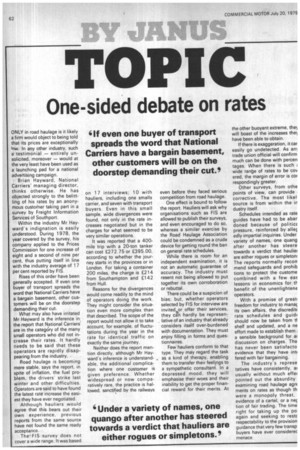TO PI
Page 64

If you've noticed an error in this article please click here to report it so we can fix it.
One-sided debate on rates
If even one buyer of transport spreads the word that National Carriers have a bargain basement, other customers will be on the doorstep demanding their cut., ONLY in road haulage is it likely a firm would object to being told that its prices are exceptionally low. In any other industry, such a testimonial .— entirely unsolicited, moreover — would at the very least have been used as a launching pad for a national advertising campaign.
Brian Hayward, National Carriers managing director, thinks otherwise. He has objected strongly to the belittling of his rates by an anonymous customer taking part in a survey by Freight Information Services of Southport.
Within the industry Mr Hayward's indignation is easily understood. During 1978, the year covered by the survey, his company applied to the Prices Commission for one increase of eight and a second of nine per cent, thus putting itself in line with the industry average of 17 per cent reported by FIS.
Rises of this order have been generally accepted. If even one buyer of transport spreads the word that National Carriers have a bargain basement, other customers will be on the doorstep demanding their cut.
What may also have irritated Mr Hayward is the inference in the report that National Carriers' are in the category of the many small operators who did not increase their rates. It hardly needs to be said that these operators are rapidly disappearing from the industry. • Road haulage is becoming more stable, says the report, in spite of inflation, the fuel problem, the drivers' strike last winter and other difficulties. Operators are said to have found the latest rate increase the easiest they have ever negotiated.
Although hauliers would agree that this bears out their own experience, previous reports from the same source have not found the same ready acceptance.
The' FIS survey does not cover a wide range. It was based on 17 interviews; 10 with hauliers, including one smalls carrier, and seven with transport buyers. Even in this small sample, wide divergences were found, not only in the rate increases negotiated but in the charges for what seemed to be very similar operations.
It was reported that a 400mile trip with a 20-ton tanker can cost £272.75 or £395.00, according to whether the journey starts in the provinces or in London. For taking a container 200 miles, the charge is £214 from Southampton and £142 from Hull.
Reasons for the divergences would come readily to the mind of operators doing the work. They might consider the situation even more complex than that described. The scope of the report would not allow it to take account, for example, of fluctutations during the year in the rate for identical traffic on exactly the same journey.
Neither does the report mention directly, although Mr Hayward's inference is understandable, the additional complication where one customer is given preference. Whether widespread or now comparatively rare, the practice is hallowed, sanctified by the railways
even before they faced serious competition from road haulage.
One effect is bound to follow the report. Hauliers will ask why organisations such as FIS are allowed to publish their surveys, and even encouraged to do so, whereas a similar exercise by the Road Haulage Association could be condemned as a crude device for getting round the ban on general rate schedules.
While there is room for an independent examination, it is not an automatic guarantee of accuracy. The industry must resent not being allowed to put together its own corroboration or rebuttal.
There could be a suspicion of bias: but, whether operators selected by FIS for interview are invited or offer their services, they ca'n hardly be representative of an industry that already considers itself over-burdened with documentation. They must enjoy filling in forms and questionnaires.
Few hauliers conform to that type. They may regard the task as a kind of therapy, enabling them to transfer their feelirigs to a sympathetic consultant. In a depressed mood, they will emphasise their woes and their inability to get the proper financial reward for their merits. At the other buoyant extreme, the will boast of the increases the have been able to obtain.
If there is exaggeration, it car easily go undetected. As am trade union official will confirm much can be done with percen tages. When there is such i wide range of rates to be coy ered, the margin of error is cor respondingly greater.
Other surveys, from othe points of view, can provide corrective. The most likel source is from within the ir dustry itself.
Schedules intended as rate guides have had to be abar doned because of politics pressure, reinforced by allet edly impartial inquiries. Under variety of names, one quang after another has steere towards a verdict that hauliei are either rogues or simpleton: The reports normally recorr mend safeguards and prohilo tions to protect the custome combined with a few eat lessons in economics for tlbenefit of the unenlightene operators.
With a promise of great' freedom for industry to manac its own affairs, the discredit( rate schedules and guidi should now be taken from ti shelf and updated, and a ne effort made to establish them a sensible background for al discussion on charges. The has never been satisfacto evidence that they have int( fered with fair bargaining.
The industry's represe tatives have consistently, ai usually without much effec pointed out the absurdity examining road haulage agrE ments on rates as though th were a monopoly threat, evidence of a cartel, or a nec. tion of fair trading. The time right for taking up the po again and seeking to rest( respectability to the provision guidance that very few transp buyers have ever considerec menace.




















































































































